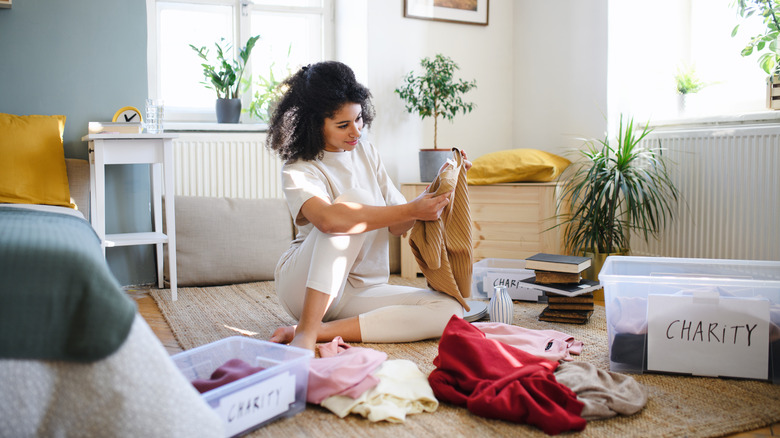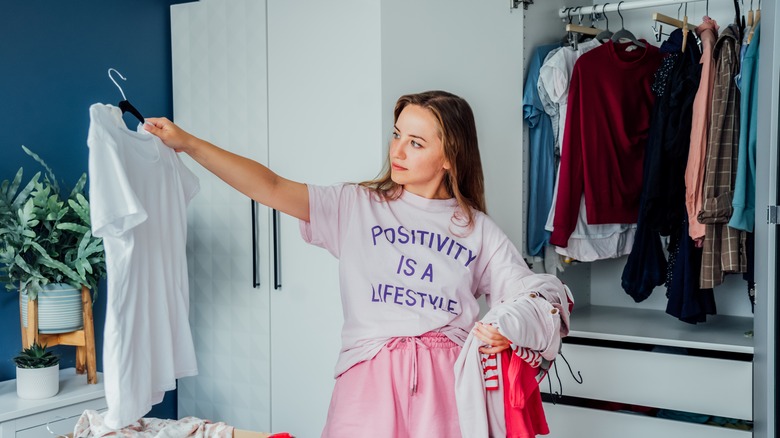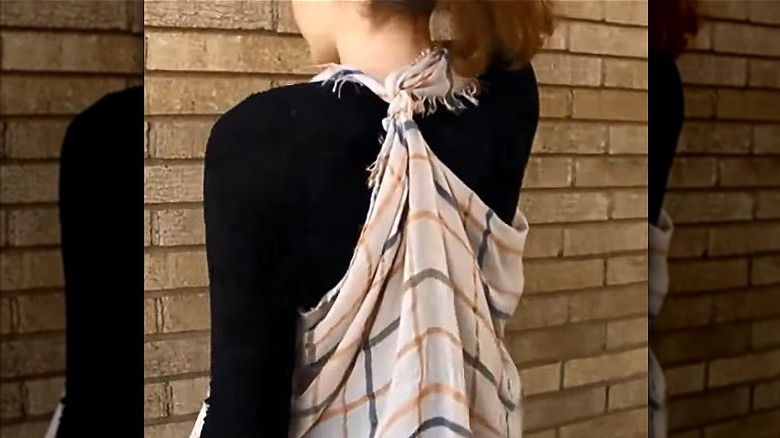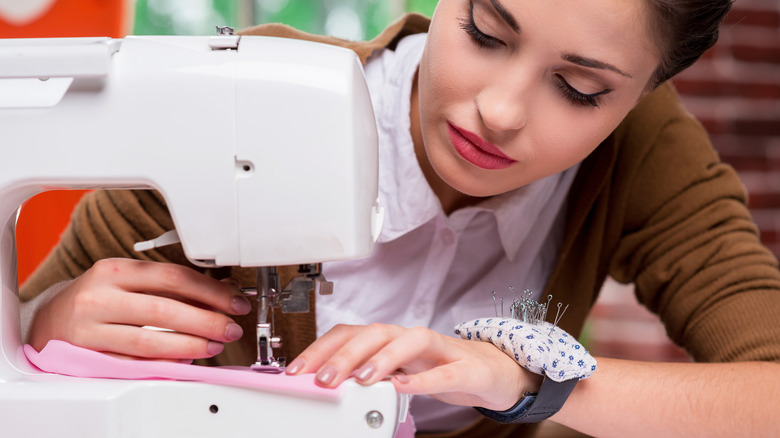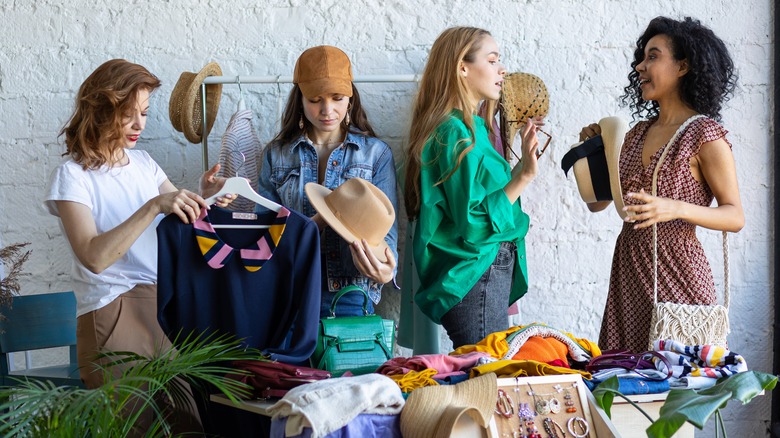How To Take A More Sustainable Approach To Purging Your Wardrobe
We may receive a commission on purchases made from links.
We're all guilty of hoarding a few too many clothes we haven't worn in the past year (or two, or three) in the back of our wardrobe. There are those super high heels we knew we'd be never be able to walk in but were just so darn pretty, that dress we bought a size smaller than we needed on the promise we'd be able to get into it one day, or all those trendy accessories we thought were oh so cool back in our youth (neon shutter sunglasses, anyone?). But sometimes, you just have to bite the bullet and say it's time for a good closet cleanout.
Unfortunately, though decluttering our wardrobe may be good for our personal space, getting rid of our clothes isn't always the best thing for the environment. Per Earth.org, more than 90 million tons worth of clothing ends up as waste, increasing the size of landfill pollution. This not only leads to environmental damage, but also contributes to a cycle of overproduction, where companies are continuously expending resources to make new items to meet consumer demand. So how exactly do you go about purging your wardrobe while prioritizing sustainability? We have some ideas.
Don't be so quick to get rid
We get it, a closet clear-out doesn't really seem legitimate unless the floor is covered in clothes. But it turns out if we truly want to take a sustainable approach to purging our wardrobe, it actually helps to not be quite so ruthless when it comes to downsizing. Earth.org says that being quick to rid of garments after a few uses contributes to "throwaway culture," or the belief that we need to constantly be disposing of and buying new clothes. Fast fashion thrives upon this. But it doesn't have to be that way.
While you certainly can't hold onto everything forever, it's always worth thinking twice before letting something go, even if it's been a while since you've used it. Speaking with Vogue, author and decluttering expert Elizabeth L. Cline advised seeing a closet cleanout as an opportunity to rediscover old items and pair them with something you may not have thought. "Pairing up [a piece] with something else [can] create this totally fresh look. Obviously, the most sustainable item in your closet is a piece of clothing that you already own," she told the publication.
Figuring out how to use your items in a new way also keeps you from buying more items you probably don't need. For inspiration, you can always look to social media sites to see how someone else may be styling an item you love.
Start with a more sustainable wardrobe
We're not pointing fingers as we've all been susceptible to some fast fashion, but setting our closets up for long-term sustainability means actually building a wardrobe with high-quality, eco conscious staples. And it sounds like our wardrobes going a little greener can't happen soon enough. "The industry will not be able to meet the growing demand of fashion from a growing world population and global middle class relying on natural resources," Erik Bang, innovation lead for the H&M Foundation, warned GreenBiz. "There is simply not enough land or water available in a long-term perspective."
Remember, being environmentally conscious is not necessarily about never buying anything ever again. However, it is about buying less, so when you do buy something it should be quality so that you don't have to buy so much, or as often. There are a number of sustainable fashion brands out there (like these amazing companies thriving in the denim world!) putting the focus on high quality products manufactured to be worn for years. AG Jeans, for example, use hemp and Tencel Lyocell fabrics, and Corozo in place of plastic so their buttons are biodegrade.
Having some well-made staples you love means you'll also have to do the whole closet purge process less often because your items will probably last longer. And don't think this has to mean dropping a ton of money, either. You can check out secondhand markets and find some high quality designer items for a discounted price.
Sell it online
As they say, sharing is caring! And selling your old clothes is one of the easiest ways to ensure your garments stay out of landfill while also giving you the added bonus of a little extra green in your pocket. And the best part is you actually don't need to set up a booth at a yard sale to list your outfits. From the old faithful Ebay to the likes of the newer Depop, online resale sites are ideal for those who want their old clothes gone fast without too much hassle.
It's also a win-win whether you're selling or buying, because purchasing items on resale sites is a great way to get something unique you may not find in stores — and you might even bag a designer item on the cheap. Saving the earth and looking crazy stylish at the same time? We love to see it!
Thankfully, buying second-hand items is only getting trendier. According to GlobalData, the apparel resale market was worth a massive $182.4 billion globally in 2022, and it's only set to get bigger! Forecasts suggest it could rise as much as 16% as we get into 2026. So whether you're buying or selling — or both — you're on trend, indeed!
Donate to charity
Another great way to grant your garments a second life is to give them away for free. By donating your used clothes to a thrift store, you can ensure they'll be properly cleaned and put back on the rack for another person to enjoy.
There are a few different options for giving your clothes away. For example, national charities like the American Red Cross has various clothing donation drop-off centers across the U.S. and in some cases, may even offer to ick up your items for you. Other organizations, like British Red Cross, have their own ebay store that allows people to purchase the item from the bidding site, with the proceeds going towards the company's various initiatives. Or you could donate your clothes to a charity like The Salvation Army or Goodwill, which have various thrift store locations across the nation. If you have an old interview outfit, you can give it to organizations like Dress For Success, which provides professional clothes to people who are trying to reenter the workforce.
It's also worth checking your local listings for donation drives to give back directly to those in your community. Many women's shelters will also accept gently used clothing as donations, too.
Keep it local
On that note, before you decide to donate your wardrobe castoffs to the first charity that pops up on a search engine, it's wise to first do some research to see what the organization actually does with items it receives. Because as much as we want to believe that donating is always a good thing, the unfortunate reality is that sometimes our good deeds aren't exactly helping people in the way we want. In fact, sometimes donating old clothes may not be helping at all.
The Guardian reported in 2014 that the East African Community was actually considering a ban on accepting donated clothing because it was having such a negative impact on the economy. In some African countries, the reliance on donated ready-made garments actually took away the need for skilled workers to make new products, resulting in fewer available jobs in that sector. Moreover, the wide availability of cheap, donated clothing also priced out locally made items, which made it challenging for business owners.
It's equally worth noting that when clothing is poorly constructed (think fast fashion) or unsuitable for wear in another environment, it can sometimes just end up landfill in the country it's donated too, despite all our efforts to avoid that. That's why sometimes the safest way to ensure your clothes are actually being reused is to donate them to a local nonprofit or shelter.
Take wearable goods back to the retailer
This may come as a surprise to some, but one of the easiest ways to be sustainable fashionista is to actually take your clothes back to where you got them in the first place. In recent years, many retail stores have adopted a green approach to clothing by accepting previously sold items for second-hand reselling, donating, or recycling. Some examples are DSW's Soles4Souls policy, which repairs old shoes and then donates them to those in need as well as Nike's Move to Zero campaign, which lets shoppers drop off previously-worn athletic clothing and shoes to stores. As explained by Refinery 29, the benefit here is twofold: it allows customers to get rid of clothes without wasting them, while also creating a market for secondhand clothing and lowering the demand for companies to keep producing an excess of new garments.
The best part, though? In many cases, the donated garments don't even need to be from that same brand. Zara's donation policy, for instance, currently allows shoppers to bring in clothes from other brands. All you have to do is make a new order and the company acts as the middle man, passing the discarded clothing along to non-profits. Reformation is doing a similar thing to help save the plane by turning previously owned clothing into new goods.
Get crafty!
Who says you have to involve a third party to help the earth? If you're willing to get crafty, you can recycle your would-have-been wardrobe cast-offs all by yourself. Not sure where to begin? You're in luck. There are tons of advice blogs out there demonstrating how to turn old garments into something new. Creator Dave Hax, for instance has a video explaining how to fashion a stylish bag from an old shirt, while Creator Clothing Cove has a video revealing how you can transform a scarf into a vest. If you're not that handy, don't fear! There are easier ways to make new use out of your clothes, like using an old t-shirt as a cleaning rag or an old scarf as a bag accessory.
Turning clothes you already own into something new yourself is one small, but meaningful way to help to slow down the demand for production of new garments, which can't happen quickly enough. "We need a drastic reduction in the production of clothing overall: a strategic degrowth of the fashion industry that is commensurate with the planetary emergency we are now in," Timo Rissanen, associate professor of fashion design and sustainability, warned while speaking to GreenBiz of how important it is for everyone to start making eco-friendly changes.
Sew sustainable
If you can learn how to repair your clothes, you'll be a total friend to the earth and your own friends. Whether it's patching up a hole in a jacket, sewing buttons back on pants, or mending rips on jeans, knowing how to extend the life of your used garments is one way to keep them from ending up in a landfill. It's also a fun way to practice a new skill, as well as save on CO2 emissions by not traveling back and forward to a store for recycling or repairs.
Learning this skill will also benefit you if you're looking to resell your clothes, as any items that aren't in a ready-to-wear condition could be with a little spruce up. Plus, it could also increase the price of that top you're listing on Depop.
With those new sewing skills, you can even take things one step further and upcycle clothes you thought you no longer wanted. You could sew new appliqué onto your old garments to give them a refresh, or you could cut off the bottoms of your jeans to make jean shorts (and donate the leftover material to be recycled). Not only will that make them more exciting to a buyer if you're looking to sell, but you may fall in love with the item all over again after seeing its new look. The possibilities are endless!
Wardrobe swap
One of the more creative and efficient ways to engage in a sustainable closet cleanout is to host a clothing swap. Instead of sending away the clothes you don't want anymore, team up with friends who are looking to give their own wardrobes a bit of a shakeup and trade pieces. The genius of this is it allows for several garments to get a second life and be used for longer. And best of all, you'll be able to have a whole lot of fun in the process!
In fact, Clothes Swap Parties are, like, a total thing right now, and they make a great excuse to gather your nearest and dearest together while also getting your hands on a brand new wardrobe. Plus, what could be more fun than seeing your friends modelling your old looks and totally rocking them? There are a couple of ways you can play this super fun concept, too. You could all treat yourselves to some new outfits for free by doing straight swaps on the garments everyone brings, or you could challenge yourselves to help non-profits by paying for the clothes and donating the proceeds to the charity of your choice.
Turn your clothes back into fibres
If your clothes have been so well loved that they're in no longer in a condition to be worn again as they are, fear not. There's a still a way for them to get a second chance: Turn them into textiles.
Per the National Institute of Standards and Technology, there are many companies and charities with recycling programs that will accept clothing items regardless of their condition and transform them into something totally new. Companies like reMATE, for instance, takes previously owned MATE brand clothing, deconstructs it, and then spins it into new yarn to make brand new clothing pieces. Not only that, but the new pieces are created with far less water than the industry standard and without metal or plastic. That means you can give away a dress you can't wear anymore and get back a new dress that's even better for the environment! Other programs like SMART, take used clothing items and grind them down into raw fibers that are granted to other businesses to create new clothes, blankets, towels, or cleaning rags. These old materials can be used for other household items, like carpet and furniture padding.
